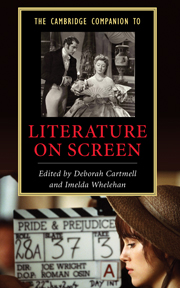Book contents
- Frontmatter
- Introduction - Literature on screen: a synoptic view
- Part One Theories of Literature on Screen
- Part Two History and Contexts
- Part Three Genre, Industry, Taste
- 8 Heritage and literature on screen: Heimat and heritage
- 9 “Don’t let’s ask for the moon!”: reading and viewing the woman’s film
- 10 Post-classical fantasy cinema: The Lord of the Rings
- 11 Adapting children's literature
- 12 Literature on the small screen: television adaptations
- Part Four Beyond the "Literary"
- Further reading
- Index
- Series List
10 - Post-classical fantasy cinema: The Lord of the Rings
from Part Three - Genre, Industry, Taste
Published online by Cambridge University Press: 28 September 2007
- Frontmatter
- Introduction - Literature on screen: a synoptic view
- Part One Theories of Literature on Screen
- Part Two History and Contexts
- Part Three Genre, Industry, Taste
- 8 Heritage and literature on screen: Heimat and heritage
- 9 “Don’t let’s ask for the moon!”: reading and viewing the woman’s film
- 10 Post-classical fantasy cinema: The Lord of the Rings
- 11 Adapting children's literature
- 12 Literature on the small screen: television adaptations
- Part Four Beyond the "Literary"
- Further reading
- Index
- Series List
Summary
Since the late 1970s the dominant genre of Hollywood blockbusters has been fantasy, and it is not hard to see why. Science fiction extravaganzas, comic book adaptations, and epic series like Star Wars (1977-2005), Harry Potter (2001 ongoing), The Chronicles of Narnia (2005 ongoing) and The Lord of the Rings trilogy (2001-2003) appeal internationally to the crucial teenage demographic; encourage fannish absorption in their expandable universes; showcase advances in special effects; and lend themselves readily to sequels, spin-offs and other commercially essential tie-ins.
Although Star Wars (1977) and Close Encounters of the Third Kind (1977), which inspired the continuing wave of fantasy, were original stories, fantasy films nowadays more usually derive from pre-existing novels, films, comic books, and video games with some built-in guarantee of audience recognition and cult interest. But the process is not one of simple “adaptation.” A film like The Lord of the Rings is a starting place as much as an end product of adaptation: just one reference point in a matrix of intertextual relations created by synergic cross-promotion. Video games, graphic and literary novelizations, CD soundtracks, multiple Director's Cuts and DVD versions, prequels, sequels, and franchises - such ostensibly secondary productions, included among what Gérard Genette called “paratexts,” not only extend the boundaries of contemporary Hollywood fantasy films but also increasingly determine their form and narrative.
- Type
- Chapter
- Information
- The Cambridge Companion to Literature on Screen , pp. 154 - 166Publisher: Cambridge University PressPrint publication year: 2007



